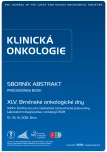IX. Nutriční podpora v onkologii
Vyšlo v časopise:
Klin Onkol 2021; 34(Supplementum 2): 43
Kategória:
IX/ 61. VÝŽIVA PACIENTŮ V PERIOPERAČNÍM OBDOBÍ U PACIENTŮ PODSTUPUJÍCÍCH DVOUDUTINOVÉ VÝKONY
FURDEK M., DVORSKÝ J.
Anesteziologicko-resuscitační oddělení, MOÚ Brno
Významnou součástí perioperační i pooperační péče u onkologických pacientů je nutriční podpora. Pacienti postupující operační výkony se souběžným chirurgickým přístupem hrudník-břicho představují rizikové pacienty jak po stránce následného pooperačního managementu, tak i po stránce nutriční, kde může být již výskyt nutričního rizika i předoperačně. Příprava pacientů k tomuto typu operační zátěže je komplexní a vyžaduje určení nutričně rizikových osob s dostatečným předstihem tak, aby případná nutriční intervence byla účinná. V pooperačním období je nutné zvládnout proces hojení a obnovení perorálního energeticko-proteinově adekvátního příjmu, kdy toto období může generovat řadu komplikovaných situací povahy jak metabolické a kardiovaskulární tak intervenční a chirurgické. Najít optimální nutriční řešení v co nejkratší době může být obtížné. Cílem je načrtnout principy poskytování nutriční podpory u pacientů hospitalizovaných na ARO-JIP MOÚ po dvoudutinových operačních výkonech a zdůraznit význam předoperační přípravy, stejně tak i závažnost a náročnost perioperačního nutričního managementu.
IX/ 280. SARCOPENIA IN ONCOLOGY – WHAT SHOULD AN ONCOLOGIST KNOW OF SARCOPENIA AND WHY
MUSCARITOLI M.1, TUČEK Š.2, RAUH S.3
1Sapienza University of Rome, Italy, 2Department of Comprehensive Cancer Care, MMCI Brno, 3Centre Hospitalier Emile Mayrisch, Esch-sur-Alzette, Luxembourg
Introduction: Sarcopenia awareness is necessary for healthcare professionals dealing with cancer. Sarcopenia is a loss of skeletal muscle mass. Its onset is common in ageing process and brings a loss of muscle function. In malignant diseases, sarcopenia occurs more often even in younger age. The loss of skeletal muscle is very unfortunate for the patients as it brings many disadvantages and problems. In oncology, the awareness of sarcopenia has increased over past couple of years. Sarcopenia is a loss of active metabolic tissue. It increases toxicity of anticancer chemotherapy, decreases response to it and is again enhanced by chemotherapy. Sarcopenia has been proven a negative predictive marker for survival in some solid cancers. In oncology, sarcopenia is caused by several factors, among many by infl ammation, immobility, increased metabolic demands and decreased nutrients intake. Sarcopenia may occur in skinny as well as in obese patients. Sarcopenic obesity is even more unfortunate for its bearer as it often remains unrecognized and untreated. A sarcopenic obese patient is even more likely to become immobile than a skinny patient. The diagnosis of sarcopenia may not be easy. It requires assessment of body composition. Purpose: To raise awareness of sarcopenia in oncology among oncologists and to suggest its diagnosis and treatment possibilities. Conclusion: Sarcopenia is common in oncology and it has many causes. It is important to diagnose sarcopenia and to treat it to together with anticancer treatment. A common tool may be BIA, an analysis of muscle mass and quality on a CT scan, functional tests and clinical assessment. In real practice, sometimes the latter one is the only available. The treatment of sarcopenia in cancer requires a broad and multidisciplinary approach. A causal anticancer treatment is necessary. Some treatments like targeted drugs may worsen the situation and more research is necessary in this field. It may be necessary to suppress the disease and treatment accompanying infl ammation, to increase nutrients intake and resistance physical exercise.
References: [1] Bozzetti F. Forcing the vicious circle: sarcopenia increases toxicity, decreases response to chemotherapy and worsens with chemotherapy. Ann Oncol 2017; 28(9): 2107–2118. doi: 10.1093/ annonc/ mdx271. [2] Blauwhoff -Buskermolen S, Versteeg KS, de van der Schueren MA et al. Loss of muscle mass during chemotherapy is predictive for poor survival of patients with metastatic colorectal cancer. J Clin Oncol 2016; 34(12): 1339–1344. doi: 10.1200/ JCO.2015.63.6043. [3] Rier HN, Jager A, Sleijfer S et al. The prevalence and prognostic value of low muscle mass in cancer patients: a review of the literature. Oncologist 2016; 21(11): 1396– 1409. doi: 10.1634/ theoncologist.2016-0066. [4] Büchler T., Hornová J. Sarkopenie u metastatického kolorektálního karcinómu. Klin Onkol 2019; 32(6): 406–410. doi: 10.14735/ amko2019406.
Štítky
Detská onkológia Chirurgia všeobecná OnkológiaČlánok vyšiel v časopise
Klinická onkologie

2021 Číslo Supplementum 2
- Metamizol jako analgetikum první volby: kdy, pro koho, jak a proč?
- Nejasný stín na plicích – kazuistika
- Fixní kombinace paracetamol/kodein nabízí synergické analgetické účinky
- Tramadol a paracetamol v tlumení poextrakční bolesti
- Realita liečby bolesti v paliatívnej starostlivosti v Nemecku
Najčítanejšie v tomto čísle
- XVI. Nádory slinivky, jater a žlučových cest
- VII. Nežádoucí účinky protinádorové léčby
- XV. Nádory tlustého střeva a konečníku
- VIII. Paliativní péče a symptomatická léčba
